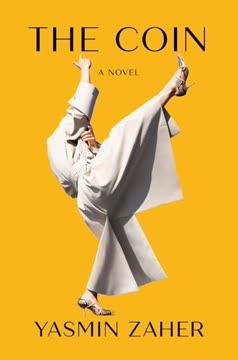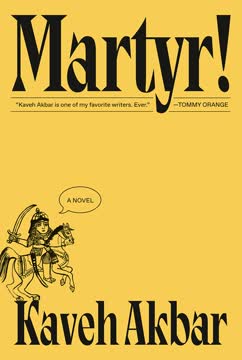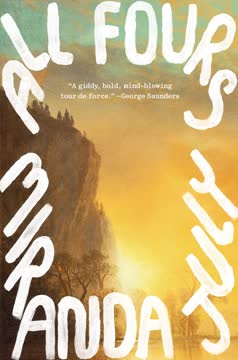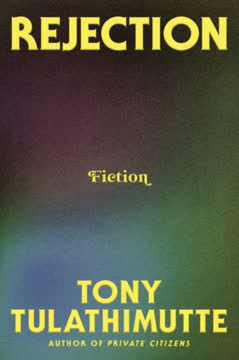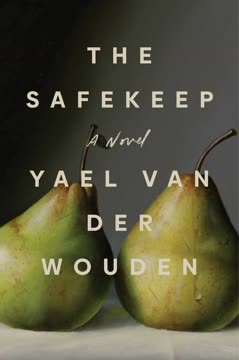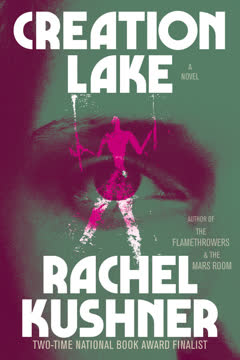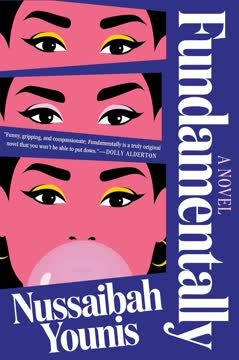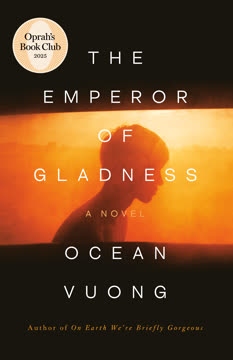Plot Summary
Dirt and Arrival
The narrator, a Palestinian woman, arrives in New York, haunted by the omnipresence of dirt—on surfaces, in corners, under nails. She takes a job teaching at Franklin, a middle school for boys, not out of necessity but for pleasure and a sense of power. Her life is a careful balance of pleasure and cleanliness, but the city's filth unsettles her. She is both enthralled and repulsed by her new environment, finding herself both an outsider and a participant in the city's relentless, dirty energy. Her routines—her skincare, her rituals—are attempts to assert control, to keep the chaos at bay. Yet, beneath her surface, she senses a deeper contamination, a dirtiness that is not just physical but existential.
The Unreachable Square
After a particularly intense cleaning ritual, the narrator discovers a patch on her back she cannot reach—a square of skin that remains untouched, unclean. This unreachable spot becomes a symbol of her limitations, her inability to fully control or purify herself. She experiments with toothpaste, mirrors, and contortions, but the square persists. The asymmetry of her body—strong right, weak left—mirrors her psychological state. The dirt she cannot remove becomes a metaphor for trauma, memory, and the parts of herself she cannot access or heal. This realization unsettles her, deepening her sense of alienation and vulnerability in her new life.
Teaching the Boys
At Franklin, the narrator finds herself both teacher and general to a group of boys, mostly Black and immigrant, dressed for a future of social mobility. She improvises lessons, sometimes abandoning the curriculum for free classes or films. She observes their anxieties, their attempts to please, and their struggles with identity. The classroom becomes a microcosm of American society—its hierarchies, its performances, its silent cruelties. The narrator's own outsider status allows her to see the boys' vulnerabilities and ambitions with clarity, but also with a certain detachment. She manipulates, encourages, and sometimes confides in them, blurring the lines between authority and intimacy.
The Coin's Origin
The narrator recalls swallowing a shekel as a child—a coin that never reappeared, neither in pain nor in excrement. This event is entwined with a deeper trauma: a car accident in which her parents died and she and her brother survived. The coin becomes a symbol of loss, inheritance, and the mysteries of the body. Her family's history is marked by failed attempts to emigrate, by curses and political violence. The coin, lodged somewhere inside her, is both a literal and figurative remnant of her past—a secret, a burden, a source of power and contamination.
Inheritance and Exile
The narrator's inheritance is substantial but inaccessible, controlled by her brother and a lawyer. She is simultaneously rich and poor, privileged and powerless. Her mother's wish was for her to go to America, but the family's history is one of repeated exile and return, of failed assimilation. America, for her, is both a dream and a devil—a place of opportunity and violence, of luxury and squalor. Her sense of statelessness is compounded by her ambiguous class position, her inability to fully belong anywhere, and her awareness of the global systems of oppression that shape her life.
Classroom Experiments
The narrator uses her autonomy at Franklin to introduce unconventional lessons—showing videos of Stokely Carmichael, assigning clandestine interviews, encouraging manipulation and performance. She recognizes the boys' exposure to hardship and their need for both protection and challenge. Her teaching is both nurturing and subversive, pushing the boys to confront uncomfortable truths about race, class, and power. Yet, she is also aware of her own limitations, her inability to fully bridge the gaps between herself and her students, between her own traumas and theirs.
Cleanliness and Control
The narrator's obsession with cleanliness intensifies. She cleans her apartment obsessively, unable to trust anyone else with the task. The city's filth becomes unbearable—she wears gloves on the subway, hems her pants, holds her breath. Cleaning is both a way to assert control and a symptom of deeper anxiety. She is haunted by the dirt of others, by the traces of previous inhabitants, by the impossibility of ever being truly clean. The act of cleaning becomes a ritual, a form of self-punishment and self-preservation, a way to manage pain and chaos.
The Body's Betrayal
The narrator's body begins to betray her—she experiences pain, anxiety, and a sense of contamination she cannot shake. She seeks comfort in rituals, in relationships, in fleeting pleasures, but nothing is enough. Her relationship with Sasha is devoid of passion, sustained by habit and convenience. Her attempts to find satisfaction—through sex, shopping, cleaning—are always undermined by a persistent sense of emptiness and decay. The unreachable square on her back, the coin inside her, and the city's relentless dirt all converge in a growing sense of crisis.
The Coin Returns
During a moment of sunbathing, the narrator feels a vibration in the unreachable square on her back—the coin, she realizes, has returned. Its presence is both strange and satisfying, a secret she can revisit in ritual. The coin becomes a focal point for her anxieties and desires, a symbol of the past that cannot be expelled. It is both a curse and a companion, a reminder of her origins and her inability to fully assimilate or escape. The coin's return marks a turning point, deepening her sense of alienation but also giving her a strange sense of identity.
Times Square Reflections
The narrator, dressed impeccably, visits Times Square and is seen by the crowds—tourists, locals, strangers. She is both visible and invisible, exotic and anonymous. The city's gaze both affirms and isolates her. She reflects on the nature of habit, the dangers of complacency, and the ways in which identity is constructed through performance and consumption. The city's luxury and squalor, its endless cycles of desire and disappointment, mirror her own internal contradictions. She is both the object and subject of longing, both powerful and profoundly alone.
Dreaming of Power
The narrator inventories her wardrobe, reflecting on the meanings of clothing, the performances of class, and the paradoxes of fashion. She admires brands that subvert taste, that make ugliness desirable, that blur the lines between rich and poor. She recognizes the cruelty and absurdity of these systems, but also their power. The truth, she concludes, is both ugly and beautiful, and the desire to possess, to be seen, to belong, is both universal and destructive. Her own relationship to power is ambivalent—she is both seduced and repulsed by the games of status and consumption.
The Student's Confession
The narrator discovers a disturbing note in a student's notebook—a threat of violence and suicide. She is shaken but chooses not to report it, instead tearing out the page and keeping the secret. She reflects on the vulnerabilities of her students, their exposure to hardship and cruelty, and her own responsibilities as a teacher. The boundaries between care and complicity blur. She takes pride in her students' small victories, their creative expressions, but is haunted by the knowledge that she cannot protect them from the world's dangers—or from themselves.
The CVS Retreat
The narrator develops an elaborate cleaning ritual—the CVS Retreat—combining products, methods, and self-discipline in a quest for purity. The ritual is both a performance and a compulsion, a way to manage anxiety and assert agency. Yet, the results are always temporary; the dirt returns, the sense of contamination persists. The ritual becomes a form of self-creation, a way to mark time, to impose order on chaos. But it is also a reminder of the limits of control, the inevitability of decay, and the persistence of the past.
Trench-coat Appears
The narrator meets Trench-coat, a mysterious, well-dressed man who becomes her companion and partner in schemes. Their relationship is marked by glamour, performance, and mutual need. Trench-coat is both a kingmaker and a valet, both masculine and feminine, both rich and homeless. Together, they navigate the city's rituals of consumption and status, finding pleasure in fashion, food, and the performance of class. Yet, beneath the surface, their relationship is fraught with tension, competition, and the impossibility of true intimacy.
Parisian Schemes
The narrator and Trench-coat travel to Paris, engaging in a scheme to buy and resell luxury handbags. The rituals of consumption, the performances of elegance, and the games of access and exclusion become central. The narrator reflects on her own identity, her relationship to money, and the ways in which value is constructed and destroyed. The city's beauty and cruelty, its hierarchies and hypocrisies, mirror her own internal struggles. The scheme is both a means of survival and a performance of belonging, but it ultimately leaves her feeling more alienated and empty.
The Movement for Beauty and Justice
Back at Franklin, the students form The Movement for Beauty and Justice, organizing bake sales, writing manifestos, and threatening strikes. The narrator is both proud and wary, recognizing the limits of their rebellion and the ways in which systems absorb and neutralize dissent. The students' desires—for beauty, for justice, for recognition—mirror her own, but their efforts are ultimately co-opted or undermined. The boundaries between teacher and student, authority and rebellion, become increasingly blurred, as the narrator's own sense of purpose unravels.
The Wallet and the Burgers
The narrator's wallet is stolen, and she suspects her students. The money is spent on luxury burgers and trinkets, a parody of the consumption and status games she herself plays. The incident exposes the fragility of trust, the ease with which ideals are corrupted, and the limits of her influence. The school itself is soon destroyed by fire and flood, a literal and symbolic collapse of the order she tried to impose. The narrator is left with guilt, anger, and a sense of failure—toward her students, herself, and the ideals she once held.
Collapse and Rebirth
In the aftermath, the narrator retreats into her apartment, transforming it into a wild, natural landscape—a new natural order. She abandons cleanliness, embraces dirt, and experiments with new ways of being. Her rituals become more primal, her boundaries dissolve, and she confronts the limits of control, the inevitability of decay, and the persistence of desire. In the end, she is left alone, stripped of illusions, but also free—able to speak, to feel, to accept the dirt and the coin as parts of herself. The story closes with a sense of hard-won self-acceptance, a recognition that nothing lasts, but that survival is itself a form of dignity.
Characters
The Narrator
The unnamed Palestinian woman at the center of the novel is defined by her acute sensitivity—to dirt, to power, to the boundaries of her own body and mind. Her psychological landscape is shaped by trauma, exile, and a persistent sense of not belonging. She is both privileged and powerless, wealthy by inheritance but constrained by circumstance. Her relationships—with Sasha, Trench-coat, her students—are marked by ambivalence, need, and a longing for both intimacy and autonomy. Her compulsions—cleaning, shopping, teaching—are attempts to impose order on chaos, but they also reveal her vulnerability and her inability to fully escape the past. Over the course of the novel, she moves from a desperate quest for purity to a hard-won acceptance of her own dirtiness, her own complexity.
Sasha
Sasha is the narrator's long-term partner, a Russian émigré in New York, successful in real estate but emotionally distant. He provides stability and material comfort, but their relationship is devoid of passion or true intimacy. Sasha is attentive, sensitive to the narrator's moods, but ultimately unable to fulfill her deeper needs. He represents the safety of habit, the comfort of routine, and the limitations of relationships built on convenience rather than desire. His presence is both a balm and a burden, and as the narrator's internal crisis deepens, Sasha becomes increasingly peripheral—a symbol of the life she cannot fully embrace or abandon.
Trench-coat
Trench-coat is a mysterious figure who enters the narrator's life as both lover and accomplice. He is a master of appearances—always impeccably dressed, able to move between worlds, both rich and homeless, masculine and feminine. His relationship with the narrator is marked by mutual need, competition, and a shared obsession with status and consumption. Trench-coat is both a kingmaker and a valet, both a source of pleasure and a reminder of the impossibility of true belonging. His presence catalyzes the narrator's descent into performance, fraud, and ultimately self-destruction. Yet, he too is ultimately revealed as vulnerable, dependent, and unable to provide lasting fulfillment.
Aisha
Aisha is the headmistress at Franklin, responsible for hiring the narrator and overseeing the school. She is warm, supportive, and genuinely invested in her students, but also constrained by the bureaucratic and social realities of her position. Aisha represents the possibility of kindness and community, but also the limits of institutional change. Her relationship with the narrator is collegial but distant, marked by mutual respect but also by the unbridgeable gaps of experience and perspective. In the end, Aisha is as powerless as the narrator to prevent the collapse of the school and the failure of their shared ideals.
Jay
Jay is one of the narrator's students, notable for his gentleness, naivety, and desire to be loved. He struggles academically but compensates through acts of service and loyalty. Jay is deeply affected by the narrator's attention and approval, internalizing her obsessions and anxieties. His vulnerability makes him both endearing and at risk—he is easily hurt, easily manipulated, and ultimately left exposed by the failures of the adults around him. Jay's trajectory mirrors the narrator's own—anxious, searching, and ultimately forced to confront the limits of care and the inevitability of disappointment.
Leonard
Leonard is the narrator's star student—intelligent, creative, and hardworking, but also introverted and weighed down by family trauma. His writing reveals a depth of feeling and insight, but he is also marked by anxiety, performance pressure, and a sense of isolation. Leonard's relationship with the narrator is complex—she admires and encourages him, but also projects her own ambitions and anxieties onto him. His eventual involvement in theft and the school's collapse reflects the fragility of even the most promising students, and the ways in which systems of care can fail those who need them most.
Sal
Sal is another of the narrator's students, notable for his style, charm, and volatility. He is both a favorite and a problem—capable of great performance but also prone to aggression and manipulation. Sal's need for attention and validation drives much of the classroom drama, and his actions often disrupt the fragile order the narrator tries to impose. His relationship with the narrator is marked by mutual fascination and discomfort, and his eventual involvement in theft and rebellion underscores the limits of authority and the dangers of unchecked desire.
Carl
Carl is the only Asian student in the narrator's class, often marginalized and bullied by his peers. His writing reveals deep depression, suicidal ideation, and a sense of alienation. The narrator's response—tearing out his note, keeping his secret—reflects the complexities of care and the dangers of silence. Carl's trajectory is a reminder of the vulnerabilities of those on the margins, and the ways in which systems of education and care can overlook or fail those most in need.
Curls
Curls is a Palestinian-American educator and activist, introduced to the narrator as a potential friend and ally. She is loud, confident, and deeply engaged in questions of identity, justice, and belonging. Her relationship with the narrator is marked by both affinity and difference—shared heritage but divergent experiences, mutual attraction but ultimate incompatibility. Curls represents the possibilities and limitations of solidarity, the complexities of diasporic identity, and the ways in which intimacy can both heal and estrange.
Sofia
Sofia is the narrator's neighbor, a clarinet player whose music becomes a backdrop to the narrator's rituals and crises. She is both a figure of fascination and a symbol of the boundaries the narrator cannot cross—her apartment, her marriage, her music, her refusal to engage. Sofia's presence is a reminder of the limits of connection, the persistence of difference, and the ways in which art and beauty can both soothe and estrange.
Plot Devices
The Coin
The coin, swallowed in childhood and never expelled, is the novel's central symbol. It represents the narrator's unresolved trauma, her inheritance, her sense of contamination and difference. The coin's physical presence—felt, imagined, returned—anchors the narrative's exploration of the body, memory, and the limits of control. It is both a curse and a companion, a reminder of the past and a source of power. The coin's journey—from ingestion to reappearance—mirrors the narrator's own trajectory, from denial to acceptance, from the quest for purity to the embrace of complexity.
Cleaning Rituals
The narrator's cleaning rituals—her skincare, her CVS Retreats, her compulsive organization—structure the novel's movement. These rituals are both attempts to impose order and symptoms of deeper anxiety. They provide moments of clarity, transformation, and self-creation, but also reveal the futility of control and the inevitability of decay. The rituals become increasingly elaborate and desperate, culminating in the transformation of her apartment into a wild, natural landscape—a final, failed attempt to create a new order.
The Classroom
The classroom at Franklin is both a site of authority and a space of experimentation. The narrator's teaching methods—her subversions, her manipulations, her encouragement of rebellion—mirror the larger dynamics of power, performance, and resistance. The students' actions—their confessions, their thefts, their formation of The Movement for Beauty and Justice—reflect the possibilities and limits of change. The classroom's eventual destruction by fire and flood is both a literal and symbolic collapse of the systems the narrator tried to control.
Fashion and Consumption
Clothing, handbags, and luxury goods are central to the novel's exploration of class, identity, and belonging. The narrator's wardrobe, her shopping rituals, and her schemes with Trench-coat are all performances—attempts to assert status, to belong, to control how she is seen. Fashion is both a source of pleasure and a site of anxiety, a way to navigate the city's hierarchies and a reminder of the impossibility of true assimilation. The rituals of consumption are both seductive and destructive, offering moments of power but ultimately reinforcing the narrator's sense of alienation.
Foreshadowing and Recurrence
The novel is structured by recurring motifs—dirt, cleaning, the coin, the unreachable square, the classroom, the city's filth. These repetitions create a sense of inevitability, of cycles that cannot be broken. The narrator's attempts to escape—through cleaning, teaching, consumption, relationships—are always undermined by the return of the past, the persistence of trauma, and the limits of control. The novel's ending, with its acceptance of dirt and impermanence, is both a resolution and a recognition of the impossibility of closure.
Analysis
Yasmin Zaher's The Coin is a dazzling, caustic meditation on exile, class, and the body's relentless betrayals. Through the narrator's obsessive quest for cleanliness and control, Zaher exposes the impossibility of purity in a world marked by violence, displacement, and commodification. The coin—swallowed in childhood, never expelled—becomes a haunting symbol of trauma, inheritance, and the parts of ourselves we cannot reach or heal. The novel's New York is both a playground and a battlefield, its luxury and squalor mirroring the narrator's own internal contradictions. Zaher's prose is sharp, darkly funny, and unflinching, capturing the absurdities of class performance, the cruelties of education, and the loneliness of statelessness. Ultimately, The Coin is a story of survival—not through triumph or transcendence, but through the hard-won acceptance of dirt, decay, and the limits of control. It is a novel for our era of precarity, a reminder that nothing lasts, but that dignity can be found in the struggle to endure.
Last updated:
Review Summary
The Coin received mixed reviews, with some praising its unique voice and exploration of trauma, displacement, and identity, while others found it confusing or pretentious. Many compared it to works by Ottessa Moshfegh, focusing on its stream-of-consciousness style and unlikeable protagonist. Readers appreciated the novel's insights into Palestinian experiences and American culture, but some struggled with its disjointed narrative and lack of resolution. The book's themes of cleanliness, wealth, and obsession resonated with many, though its experimental style divided opinions.
Similar Books
Download PDF
Download EPUB
.epub digital book format is ideal for reading ebooks on phones, tablets, and e-readers.
